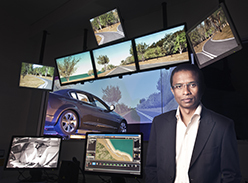Connected cars have 1980s-level security

The era of the smart car is arriving, with autonomous vehicles already driving test runs on roads and in-car navigation and entertainment systems growing more sophisticated.
But QUT road safety expert professor Andry Rakotonirainy warns that without improved security, the risk of car hacking is real.
“The security protection on cars is virtually non-existent, it is at a level of protection that a desktop computer system had in the 1980s; the basic security requirements such as authentication, confidentiality and integrity are not strong,” he said.
“What this means is that as vehicles become more and more connected and autonomous, with the ability to communicate to other vehicles and infrastructure through wireless networks, the threat of cyberattack increases - putting people’s safety and security at risk.”
The evolution of intelligent transport systems means that new cars could soon start coming with wireless internet access as standard, leaving them vulnerable to network threats.
All new cars also come equipped with a technology called CAN-BUS, he said, which can be used to control almost everything in the vehicle including airbags, brakes, cruise control and power steering systems. This system can be accessed locally or remotely with simple devices.
Future cars will soon be wirelessly connected to other cars and possibly to road infrastructure including traffic lights, Rakotonirainy added. While this has the potential to improve road safety, if hacked people’s lives could be at risk.
“If someone hacks into a vehicle’s electronics via a wireless network and exploits the current security loophole, they can track or take control of it,” he said.
Rakotonirainy urged car makers, government and road safety experts to turn their attention to the global security threat posed by vulnerable connected vehicles.
“A vehicle’s communication security over wireless networks cannot be an afterthought and needs to be comprehensively considered at the early stages of design and deployment of these high-tech systems from the hardware, software, user and policy point of view.”
Rakotonirainy will be speaking at the Occupational Safety in Transport Conference (OSIT) on the Gold Coast this week to warn of the new security threats posed by smart connected cars.
Secure-by-design software development for digital innovation
The rise of DevSecOps methodologies and developments in AI offers every business the opportunity...
Bolstering AI-powered cybersecurity in the face of increasing threats
The escalation of complex cyber risks is becoming a pressing issue for those in business...
How attackers are weaponising GenAI through data poisoning and manipulation
The possibility for shared large language models to be manipulated through data poisoning...







